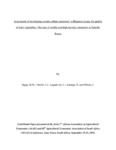| dc.description.abstract | The improvement in income in developing countries has led to emergence of middle and high
income consumers in urban centers. Improvement in income usually causes the shift to
consumption of non-staples including leafy vegetables. Thus in major developing country urban
centers there has been rapid expansion of the grocery sections featuring leafy vegetables in
leading retail stores. Specialty stores have also emerged featuring broad range vegetables. Many
middle and high income consumers shop these stores. This study examines the willing of the
middle and high income consumers who shop specialized stores to pay for quality of leafy
vegetables and drivers of willingness to pay for quality. The study uses contingent valuation and
the payment card method in eliciting consumers’ WTP. It considers a broad range of quality
attributes including safety, nutrition, environmental friendliness, hygiene in handling. The study
finds that mean willingness to pay for quality is higher among high income consumers (>60%).
It also finds that income, age of children the consumer has, access to information of food safety
are among the significant drivers of kale consumers’ willingness to pay for quality of kales. The
study concludes that there is demand for quality of leafy vegetables and discusses policy
implications | en_US |

